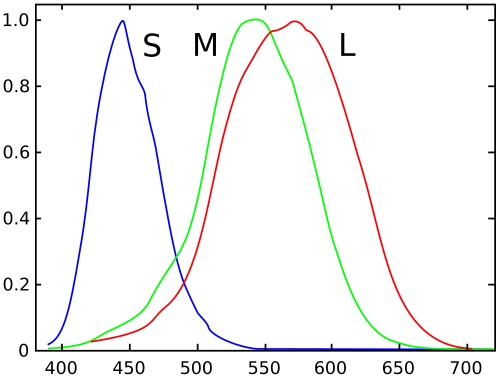There are exceptionally few human individuals on the planet who can see beyond the range of 380nm to 750nm. That would be more of a maximum range, factoring in the weakest sensitivities under stringent testing conditions, which is quite different than normal vision on a normal day to day basis. Realistically, I'd say human vision on the average case is from ~400nm to ~700nm or so.
I used to do extensive research in color theory and how it pertained to human vision. There are some rare genetic aberrations that give some people much more limited sensitivity to light, usually the loss of function in one type of cone (this usually leads to one of the various forms of color blindness). A very small percentage of women seem to have an extra cone color, called the orange cone with an 'orange yellow-orange' color, within the 2° foveal spot. It isn't well understood how this extra cone works with the normal process of vision, although it seems to be sensitive to a narrower band than standard red cones. Some scientists suspect it is simply a differently or malformed red cone, and is therefor treated as a red cone by the brain. Being sensitive to light wavelengths closer to green than standard red cones and not sensitive to blue light at all, it may not significantly change the range of wavelengths these women are sensitive to, if it changes the range at all. I don't know of any human who has even more than the most minimal sensitivity to frequencies around 380nm, although I've read some obscure things about other rare diseases that might enhance sensitivity to blue and purple hues. Some humans are rarely sensitive down to 780nm, however sensitivity levels are extremely low (notice the right-hand shoulder of the green sensitivity curve below, how it tapers off very slowly to the end of the graph...something like that, only with the red sensitivity curve.)
Human vision is a tristimulus, we see three primary bands of light...the reds, the greens, and the blues, however our red cones are also visible to some blue as well (which is what gives us the ability to see magenta.) The spectral response of the cones in the vast majority of human eyes is as follows:
The blue curve produces a narrower peak, with little overlap with green and red sensitivity (although do note that red sensitivity reaches almost to 400nm). You can see how rapidly blue sensitivity falls off after ~420nm, down to nothing by 380nm. Even if that faloff curve was extended or even shifted to 370nm or 360nm, it is not going to greatly enhance our sensitivity to near-uv. Official range measurements for cone sensitivity in humans is as follows:
| Cone | Range | Peak |
| S (Blue) | 400-500nm | 420-440nm |
| M (Green) | 450-630nm | 534-555nm |
| L (Red) | 500-700nm | 564-580nm |
The widest variations in human vision are primarily caused by defects in the way rods and cones form. This is primarily dominated by color blindness, which basically punches holes in the spectrum of visible light which color blind individuals can see. The various forms of color blindness each affect anywhere from 1% to 5% of the population, depending on the kind. An ultra-rare group of people on earth have monochromatic vision (lack of functioning cones entirely), therefor they see the world in black and white with only their rods. Another exceptionally rare forms of color blindness result in random interpretation of various wavelengths of light (knew someone like this when I was a kid...he would organize crayons into a "rainbow" according to how his brain interpreted each color...it looked completely random and without pattern or sequence to everyone else...weirdest vision impairment I've ever encountered in my life, and his impairment was around one in a billion, so exceptionally rare.)
In all honesty, outside of the orange cones in a very small percentage of women, I don't really know of any regular wild variations in cone type and spectral sensitivity, nor anyone who can really see UV light...even if they had a sensitivity to it, it would be so minimal that it wouldn't affect their vision much in a regular basis. They would probably only learn they had such a sensitivity in a carefully controlled scientific test space and shown deep violet and UV lights of varying frequencies. It certainly isn't common enough to be of concern in the context of photography. Extreme exposures to UV light can and will certainly damage your eyes, and indeed it can cause terrible ailments like cataracts...but that doesn't actually have anything to do with how sensitive our cones are to UV frequencies.
As for people seeing 1064nm lasers...you gotta provide some references to that one! I might be able to understand the use of such a laser to stun someone or temporarily blind them with a short pulse, however that is
well beyond the range of human eyesight. Well beyond. I highly doubt more than a handful of people on earth could see that, if even one person at all could see infrared energy if that frequency.

